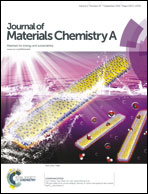Engineering of ZnCo-layered double hydroxide nanowalls toward high-efficiency electrochemical water oxidation†
Abstract
The construction of highly efficient electrocatalysts for water splitting has played an important role in developing sustainable energy sources. Herein, binary zinc–cobalt layered double hydroxide (ZnCo-LDH) films were directly grown on a conductive metal foil by a facile electrodeposition method. The as-deposited ZnCo-LDH films were composed of highly oriented nanowalls with the ab plane vertical to the substrate. The interconnected two-dimensional (2D) LDH nanosheets acted as basic units for the nanowall architectures, which exhibited excellent catalytic activity for electrochemical water oxidation in alkali solution. The onset overpotential of the optimal LDH catalyst for oxygen-evolving reactions is ∼0.33 V in an alkali solution, superior or comparable to those of well-known Co-based electrocatalysts (e.g. Co3O4). The turnover frequencies (TOFs) of ZnCo-LDH catalysts show a linear dependence on the overpotentials, higher than that of monometallic cobalt hydroxide at the overpotential beyond 0.55 V. For instance, at the overpotential of 0.7 V, the TOF value (3.56 s−1) of the optimal LDH is 1.7 times higher than that of monometallic cobalt hydroxide and is 4 times higher than that of LDH powder prepared by a co-precipitation method. The high catalytic activity is attributed to the highly sufficient exposure of accessible active sites on the vertically grown 2D nanosheets. Therefore, this study provides an effective way for preparing high-performance electrocatalysts based on LDH nanosheets, which are beneficial to practical engineering applications owing to their robust binding and integrated construction on metal substrates with any desirable shape.


 Please wait while we load your content...
Please wait while we load your content...